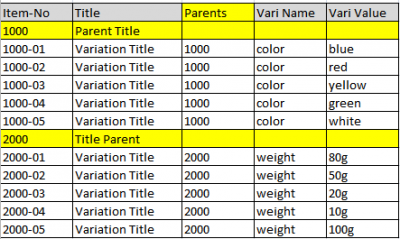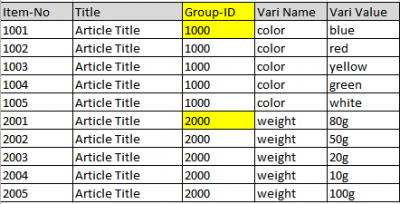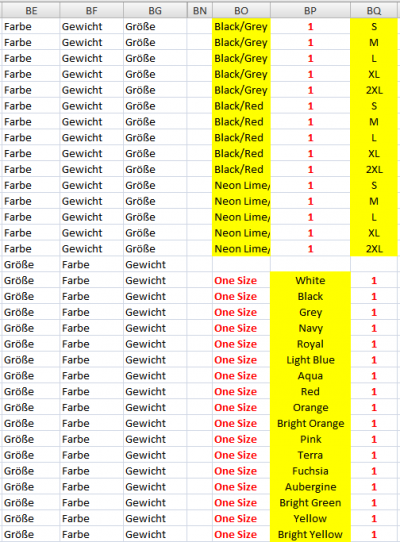Produkte Varianten/en: Unterschied zwischen den Versionen
Haemel (Diskussion | Beiträge) |
Haemel (Diskussion | Beiträge) (Die Seite wurde neu angelegt: „This must be done for all parent records. Should part numbers have been changed or new numbers been added in the import file, you have to adjust (if necessary)…“) |
||
| Zeile 71: | Zeile 71: | ||
# Don't forget to save! | # Don't forget to save! | ||
| − | + | This must be done for all parent records. Should part numbers have been changed or new numbers been added in the import file, you have to adjust (if necessary) the respective parent records. | |
Version vom 30. März 2016, 16:33 Uhr
Variants can be, for example, necklaces in different lengths (cm): 1010-42, 1010-45, 1010-50 or T-shirts in different colors: 1020-red, 1020-blue and 1020-green. There are several ways to map variant products in the system. Which way you prefer depends on the structure of your records, on your procedure or even on the platform to which your data shall be transferred.
Inhaltsverzeichnis
Search
Search Term - Enter a keyword or product ID.
Parents
Parents can be saved as separate data records in a Data Pool: [ Create new Parent ]. You can then assign any products as a variants to this parent. Once created, you can delete these parents also at any time. By the way; only the parent data record, but not the individual products will be deleted.
Example 1
Parent as separate data record:
- Parent-ID: P12345
- Variants: 12345-white, 12345-red, 12345-black, 12345-blue
- There is a 'real' separate parent data record and 4 associated variants. Thus, 5 records are stored in the Data Pool. The 4 variants have the parent ID 'P12345' in the Parent ID cell.
Example 2
Import file with parents as separate data records:
Parents can also be created in the Data Pool automatically using the import function. For this to work, parent records must be present in the import file. The SKU and description of these parents should (if possible) distinguish them from the variants.
Group-IDs
Group-IDs are the most commonly used form in the representation of variants. These group-IDs are not stored in separate data records, but only as an ID (a group identifier) in the data records of the associated variants. Optional these Group-IDs may be converted into parents. Click on the button [Create Parent(s) NOW].
Example 1
Group-IDs:
- Variants: 12345-white, 12345-red, 12345-black, 12345-blue
- In the data pool only the 4 variants are stored. In each of the 4 variants a group-ID is stored - in this case the number 'P12345'. A 'real' parent as a separate data record does not exist.
Example 2
Import file with Group-IDs:
Please, always use the import function, if you want to create a larger number of variant products.
Variants' Particularities
Filter Variants
The following illustration is intended to represent two products with different variations. The attribute weight has a value of '1' for all items. The value for size in the lower part is for all variants 'One Size'. Strictly speaking, these values are no attributes for variations. So, what to do when you want to export in the upper part only color or size and in the lower part only the color as a variant?
Suppose that the products have already been imported as variants with a parent ID. Then proceed as follows:
- Data Pool -> Products -> Tab [Variants] -> Click on tab [Group ID]
- Mark a record on the left and click the button [Create Parent(s) NOW ] at the bottom right
- Click on the tab [Parents]. There you find the newly created Parent.
- Open the record and assign the variations that you want to that parent. If, for example, items differ by their "color", select for this field 'Use as 1st variant' from the drop down menu besides it.
- Don't forget to save!
This must be done for all parent records. Should part numbers have been changed or new numbers been added in the import file, you have to adjust (if necessary) the respective parent records.
Variants for Amazon
Parents auf Amazon dürfen folgende Angaben nicht enthalten:
- Bestand
- Preis
- EAN-Nummer
- Artikelmerkmale
Hinweise zu Attributen bzw. Artikelmerkmalen:
- Bei Maßeinheitenfeldern wie z.B. Länge, Breite, Höhe, Gewicht müssen korrekte Maßeinheiten eingegeben werden.
- Im Feld Größe (Size) sind je nach Kategorie nur spezielle, durch Amazon vorgegebene Werte zulässig
- In bestimmten Feldern, meistens mit der zusätzlichen Bezeichnung ...Name (z.B. SizeName), lassen sich eigene Werte verwenden. Diese Werte müssen zuvor im System angelegt werden.
- Artikeleigenschaften parent und child müssen immer klein geschrieben werden.
- Artikelmerkmale ändern sich anhand der ausgewählten Kategoriezuordnung auf Amazon.


